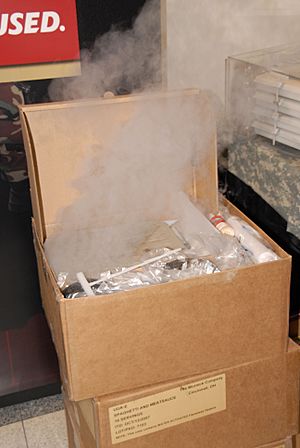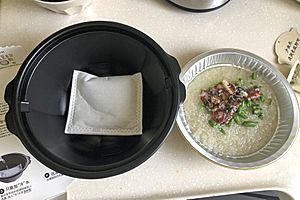Self-heating food packaging facts for kids
Imagine having a hot meal or drink without needing a stove, microwave, or even a fire! That's exactly what self-heating food packaging does. These special packages can warm up their contents all by themselves. They use a clever trick: a chemical reaction that creates heat. This makes them super useful for soldiers, people helping after natural disasters, or anyone camping or exploring where there's no kitchen. They're perfect for heating up main courses like yummy stews or hot chocolate, making them much more enjoyable.
How These Packages Get Hot
The secret to self-heating food is a special chemical reaction that gives off heat. Scientists call this an exothermic reaction. It's like a tiny, safe explosion of warmth inside the package!
Most self-heating cans are built with three layers. The food or drink is in the middle. Around it, there's a special heating agent and a small amount of water, kept separate by a thin wall. When you're ready to eat, you press a button or pull a tab on the can. This breaks the wall, allowing the water and heating agent to mix. When they mix, they react and create heat, warming up your meal or drink.
The Science Behind the Heat
Different self-heating products use different ingredients to make heat. Here are some common ones:
- Quicklime and Water: One popular method uses a substance called quicklime (which is also known as calcium oxide) and water. When quicklime and water mix, they create a lot of heat. Quicklime is safe and easy to find.
- Magnesium and Salt: Another way to make heat is by mixing finely powdered magnesium metal (which has a little bit of iron in it) with table salt. When you add water to this mix, it also creates heat. This is often used in special heaters for military meals, called MREs (Meals, Ready-to-Eat).
Some newer heating methods use special metal powders that react with metal oxides, similar to how a sparkler works, to create heat.
How the Cans Are Made
Self-heating cans are designed with two main sections, one inside the other.
In one design, your food or drink is in the inner part. The chemicals that make heat are in the outer part. When you pull a ring on the can, it breaks a barrier, letting the chemicals mix with water and heat up your meal.
In another design, the heating chemicals are in the inner section, and your drink surrounds them in the outer section. To start heating, you push on the bottom of the can. This breaks the wall between the chemicals and the water. This design is often better because less heat escapes into the air, and the outside of the can doesn't get too hot to hold.
No matter the design, once the heat from the reaction has warmed up the food or drink, you can enjoy a hot meal or beverage, even when you're far from a kitchen!



